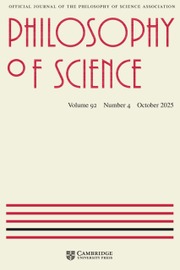Crossref Citations
This article has been cited by the following publications. This list is generated based on data provided by Crossref.
da Costa, Newton
and
French, Steven
2000.
Models, Theories, and Structures: Thirty Years On.
Philosophy of Science,
Vol. 67,
Issue. S3,
p.
S116.
Hendry, Robin Findlay
2001.
Tools and Modes of Representation in the Laboratory Sciences.
p.
221.
Morgan, Mary S.
2001.
Models, stories and the economic world.
Journal of Economic Methodology,
Vol. 8,
Issue. 3,
p.
361.
Edmonds, Bruce
2001.
Multi-Agent-Based Simulation.
Vol. 1979,
Issue. ,
p.
15.
Morgan, Mary S.
2002.
Fact and Fiction in Economics.
p.
178.
Dohmen, Thomas J.
2002.
Building and using economic models: a case study analysis of the IS-LL model.
Journal of Economic Methodology,
Vol. 9,
Issue. 2,
p.
191.
French, Steven
2003.
A Model-Theoretic Account of Representation (Or, I Don't Know Much about Art…but I Know It Involves Isomorphism).
Philosophy of Science,
Vol. 70,
Issue. 5,
p.
1472.
Glennan, Stuart
2005.
Modeling mechanisms.
Studies in History and Philosophy of Science Part C: Studies in History and Philosophy of Biological and Biomedical Sciences,
Vol. 36,
Issue. 2,
p.
443.
Guala, Francesco
2005.
The Methodology of Experimental Economics.
Hughes, R.I.G.
2006.
Theoretical Practice: the Bohm-Pines Quartet.
Perspectives on Science,
Vol. 14,
Issue. 4,
p.
457.
Knuuttila, Tarja
2006.
Simulation.
Vol. 25,
Issue. ,
p.
41.
Bueno, Otávio
2006.
Representation at the Nanoscale.
Philosophy of Science,
Vol. 73,
Issue. 5,
p.
617.
Nerlich, Brigitte
2007.
Media, Metaphors and Modelling.
Science, Technology, & Human Values,
Vol. 32,
Issue. 4,
p.
432.
Koponen, Ismo Tapio
2007.
Models and Modelling in Physics Education: A Critical Re-analysis of Philosophical Underpinnings and Suggestions for Revisions.
Science & Education,
Vol. 16,
Issue. 7-8,
p.
751.
Peschard, Isabelle
2007.
Participation of the Public in Science: Towards a New Kind of Scientific Practice.
Human Affairs,
Vol. 17,
Issue. 2,
p.
138.
Grüne-Yanoff, Till
2009.
Learning from Minimal Economic Models.
Erkenntnis,
Vol. 70,
Issue. 1,
p.
81.
de Donato Rodríguez, Xavier
and
Zamora Bonilla, Jesús
2009.
Credibility, Idealisation, and Model Building: An Inferential Approach.
Erkenntnis,
Vol. 70,
Issue. 1,
p.
101.
SPIEGLER, PETER
and
MILBERG, WILLIAM
2009.
The taming of institutions in economics: the rise and methodology of the ‘newnew institutionalism’.
Journal of Institutional Economics,
Vol. 5,
Issue. 3,
p.
289.
Edmonds, Bruce
2009.
Epistemological Aspects of Computer Simulation in the Social Sciences.
Vol. 5466,
Issue. ,
p.
169.
Downes, Stephen M.
2009.
Models, Pictures, and Unified Accounts of Representation: Lessons from Aesthetics for Philosophy of Science.
Perspectives on Science,
Vol. 17,
Issue. 4,
p.
417.

